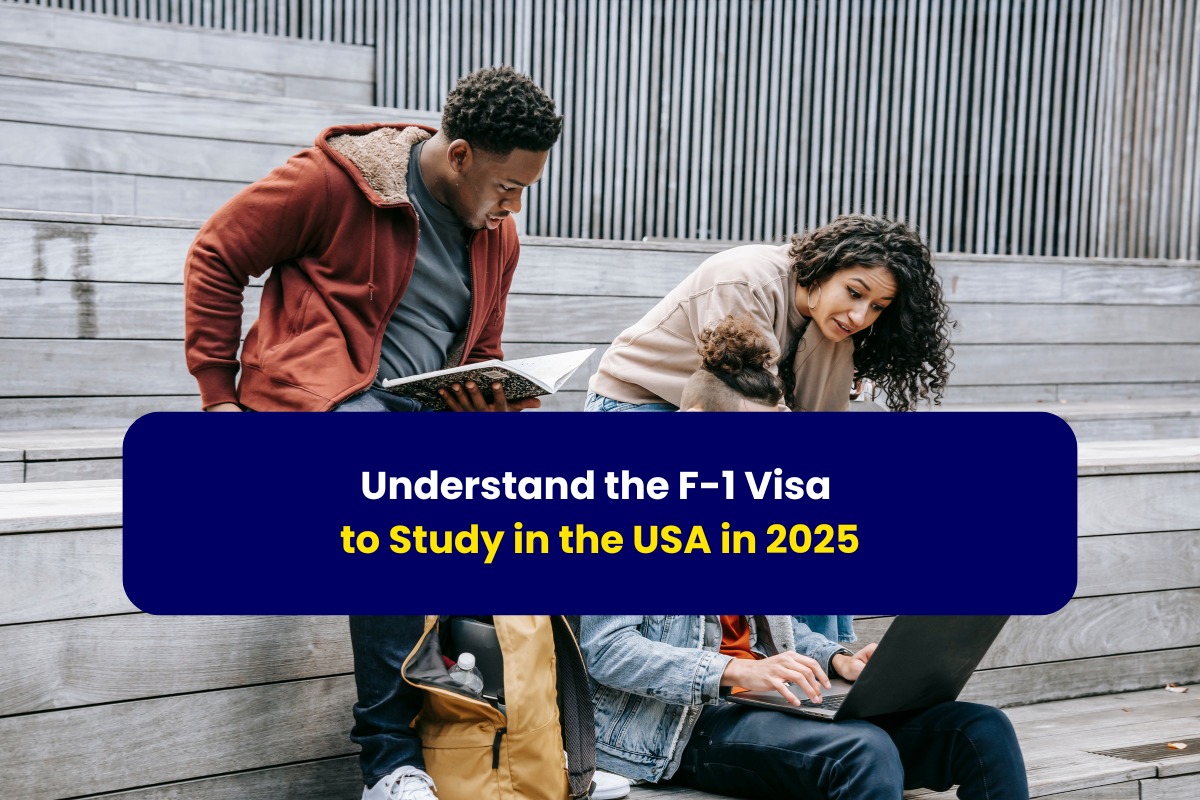Understand the F1 Visa to Study in the USA in 2025

Understand the F1 Visa to Study in the USA in 2025
Getting an F1 visa is a big step for Indian students who want to study in the USA. In 2023-2024, over 330,000 Indian students enrolled in U.S. universities. This was a 23% increase from the previous year. India is now the top source of international students in the U.S.
The U.S. offers the best universities, advanced research, and global career opportunities. But the visa process can feel stressful. You need the right documents and must prepare well for the interview. Moreover, the 2025 updates bring positive changes that might help your application. So, keep reading to understand everything you need to get visa approval.
All About the Student Visa in the USA
The F1 visa is a non-immigrant student visa that allows you to study in the United States at an SEVP-approved institution. If you enroll in an academic program like a bachelor’s, master’s, or Ph.D. degree at a U.S. university, you must apply for an F1 student visa.
With this visa, you can stay in the U.S. for your studies. You also get opportunities to work under specific conditions. These include On-Campus Employment, Curricular Practical Training (CPT), and/or Optional Practical Training (OPT). However, you must follow strict rules to maintain your visa status throughout your stay.
Who Can Apply for an F1 Visa?
To qualify for an F1 study visa, you must meet these requirements:
⦁ Acceptance into an SEVP-Approved Institution: A U.S. university, language school, or community college must send you an admission letter. The institution must have the Student and Exchange Visitor Program (SEVP) certification.
⦁ Enroll in a Full-Time Course: You must take a full-time course load, which usually means at least 12 credit hours per semester for undergraduate programs.
⦁ Prove English Proficiency: If you come from a non-English-speaking country, you must show that you can understand and communicate in English. Many universities require you to take TOEFL, IELTS, or other English proficiency tests.
⦁ Show Financial Proof: You must provide evidence that you can pay for tuition, living expenses, and other costs while studying in the U.S. You can submit bank statements, affidavits of support, or sponsorship letters.
⦁ Demonstrate Non-Immigrant Intent: You must convince the visa officer that you plan to return to your home country after completing your studies. You can provide proof of family ties, job prospects, or property ownership.
Essential Test Scores and Academic Credentials
Before you apply for an F1 visa, you must meet the admission requirements of your chosen university. These include:
⦁ English Proficiency Tests: TOEFL, IELTS, PTE, or Duolingo (depends on the university).
⦁ Standardized Tests: SAT or ACT (for undergraduate programs), GRE or GMAT (for master’s and MBA programs).
⦁ Academic Transcripts: You must submit high school or university transcripts, certificates, and diplomas. If the documents are not in English, you must provide official translations.
⦁ Letters of Recommendation: Most universities require two to three recommendation letters from teachers, professors, or employers.
⦁ Statement of Purpose (SOP) or Essays: Some schools ask you to write a personal statement explaining why you want to study in the U.S.
Study Budget for an F1 Visa
The U.S. government wants to ensure that you can afford your education. You must show financial proof for these expenses:
⦁ Tuition Fees: U.S. universities charge $10,000–$50,000 per year. It depends on the institution and program.
⦁ Living Expenses: You need around $10,000–$20,000 per year for housing, food, and transportation.
⦁ Health Insurance: Most universities require you to buy health insurance, which costs around $1,000–$3,000 per year.
⦁ Proof of Funds: You must submit bank statements, sponsorship letters, or loan approval letters. If you receive a scholarship, you must include the confirmation letter.
Preparing Documents for an F1 Student Visa
Once you receive your university acceptance letter, you must prepare these documents for your F1 student visa application:
⦁ Form I-20: Your university issues this document to confirm your admission and estimated expenses.
⦁ SEVIS Fee Payment: You must pay the SEVIS (Student and Exchange Visitor Information System) fee of $350.
⦁ DS-160 Form: You must complete this Online Nonimmigrant Visa Application Form and print the confirmation page.
⦁ Valid Passport: Your passport should remain valid for at least six months after your planned stay in the U.S.
⦁ Financial Documents: You need to provide bank statements, affidavits of support, scholarship letters, or loan approval letters.
⦁ Academic Documents: You must bring transcripts, test scores (TOEFL, IELTS, SAT, GRE, GMAT), and degree certificates.
⦁ Visa Interview Appointment Confirmation: After submitting the DS-160 form, you must schedule a visa interview at the U.S. Embassy or Consulate in your country.
Appearing at the F1 Visa Interview
The F1 visa interview is the most important step to study in the USA. The consular officer will ask you questions to check your eligibility. Follow these steps to prepare:
Schedule Your Interview: Appointment slots fill up quickly, so schedule your interview as soon as possible.
Arrive On Time and Dress Professionally: Wear formal or business attire to make a good impression.
Practice Common Interview Questions: The officer will ask about your university choice, study plans, finances, and career goals. Some common questions include:
⦁ Why did you choose this university?
⦁ How will you pay for your studies?
⦁ What do you plan to do after graduation?
Be Honest and Confident: Give clear and direct answers. If you don’t know something, admit it instead of guessing.
Bring All Required Documents: Organize your passport, I-20 form, DS-160 confirmation, financial proof, and academic records in a secure folder.
Post-Interview Scenario
Visa Approval: If you pass the interview, the officer will stamp your passport with the F1 visa. You will get your passport back in a few days.
Visa Denial: If the officer denies your visa, they will explain the reason. You can reapply after fixing the issue.
F1 Student Visa Requirements Update 2025
The F1 visa process saw some updates in January 2025. It is now more flexible for international students who want to study in the USA. These changes create better opportunities for students while ensuring they stay up to date about important policies.
⦁ Dual-Intent Policy: You no longer have to prove that you will return home after graduation. This change makes it easier to apply for longer-term immigration opportunities if you plan to stay in the U.S. after completing your studies.
⦁ Faster Work Authorization Processing: The processing times for OPT (Optional Practical Training) and STEM OPT are now lower. You can start working sooner without long waiting periods.
⦁ Cap-Gap Extension for H-1B Applicants: If you transit from an F1 visa to an H-1B work visa, this extension will prevent any employment gaps. This will ensure a smooth transition.
⦁ Study Abroad Limitations: If you leave the U.S. for a study-abroad program that lasts more than five months, your F1 student visa status will be affected. Check with your university before making long-term travel plans.
⦁ Potential Changes in Immigration Policies: While current F1 visa requirements remain the same, upcoming policy discussions, including Project 2025, may lead to future changes. You should stay up to date on official announcements.
⦁ Travel Advisories for International Students: Some universities, such as the University of Houston and the University of California, advised continuing students to return to the U.S. before January 2025 to avoid potential re-entry issues.
Tips to Boost Your F1 Student Visa Approval Chances
To increase your chances of F1 visa approval, go beyond the basics. These lesser-known tips can make a real difference in your application and interview process.
Use the Exact Information from Your I-20 in the DS-160 Form:
When filling out your DS-160 visa application, make sure your name, university details, and SEVIS number match exactly as they appear on your I-20 form. Even small differences, like missing middle names or different address formats, can cause delays or rejections.
Pay the SEVIS Fee at Least 3 Days Before Your Visa Appointment:
Your SEVIS fee payment must be processed before your interview. Pay it at least three days in advance, and carry a printed payment confirmation receipt to avoid issues.
Choose the Right Visa Interview Slot:
Morning appointments (8 AM - 10 AM) are better because officers are just starting the day and less likely to rush. You can avoid booking appointments on Mondays or Fridays, as officers may be in a hurry.
Answer the “Why This University?” Question Smartly:
Instead of generic answers like "It’s a top-ranking university", mention:
⦁ Unique courses that fit your career plans.
⦁ Research opportunities in your field.
⦁ Faculty expertise that aligns with your interests.
Keep Your Digital Footprint Clean:
Visa officers can check your social media. Avoid posts that suggest immigration intentions or job-seeking in the U.S. before approval. You should not have anything that contradicts your visa application details.
Do a Mock Interview with a Strict Evaluator:
Ask a mentor or senior student to conduct a mock interview and give critical feedback. Focus on:
⦁ Clear, confident answers.
⦁ No long pauses or hesitation.
⦁ Avoid over-explanation. Keep it direct.
Mention Career Plans That Involve Returning Home:
Even if you plan to stay long-term, show that you have strong reasons to return after graduation. You can say that you:
⦁ Want to work for a multinational company in your home country.
⦁ Will contribute to the family business, which needs your expertise.
⦁ Plan to start a business in your country.
Double-Check Your Photo Before Submission:
Your visa photo must follow strict guidelines. If it doesn’t meet U.S. embassy standards, your application could face delays. Use the official U.S. State Department photo tool to verify before uploading.
Rounding Up
The F1 visa remains the primary pathway for international students to gain legal rights to enter and remain in the USA as an international student. 2025 brings some requirements and policy changes that can impact your application and stay. While work opportunities and immigration pathways have become more flexible, increasing scrutiny and evolving visa policies mean you must stay up to date if you plan to study in the USA. Plan ahead, follow the latest guidelines, and prepare a strong application to secure your dream of studying in the USA.



